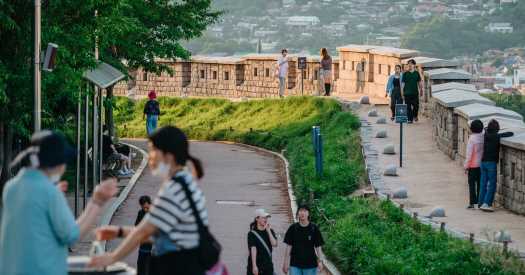
A Walk in Seoul: Following the Fortress Wall
06/20/2023To walk along the Seoul City Wall is to walk in the footsteps of scholars of bygone centuries, trace scars of war and take in the modern behemoth of a city built around it all. Its history stretches back to 1396, to when present-day Seoul first became the capital of what was then a kingdom called Joseon.
Then, the wall encircled an area that’s but a small fraction of today’s sprawling city, incorporating the slopes of the four mountains that afforded natural fortification. Like Seoul itself, the wall has been destroyed and rebuilt several times — and after restorations in recent decades, it’s become a popular urban walk.
Exploring the entire 12.5-mile loop would take a whole day, but you can take in the most scenic parts, along its northern half, in about four hours. Pick up the trail on the loop’s western edge, a short distance uphill from Muak Children’s Park, and follow its immediate steep ascent, going clockwise along the wall.
About 15 minutes in, you’ll skirt a giant boulder and come to your first vista point, which reveals the wall snaking between the trees, the Seoul Tower and nearby Gyeongbokgung Palace.
By The New York Times
Next is a short descent followed by another heart-pumping climb. Three quarters of a mile into the walk, you’ll be standing atop the first of three mountains, the 1,100-foot-high Inwangsan. You’ll see signs for “Hanyangdoseong,” as the wall is known in Korean (“Hanyang” is the historic name for Seoul). Make a sharp left coming down from the peak to find the trail. As you descend, start looking for stones marked with Chinese characters embedded in the wall — there are around 290 of them, bearing the names of the people who constructed sections of the wall.
Stay along the wall and follow signs for Changuimun Gate, the first of four gates you’ll encounter on the walk. (There were originally eight along the wall; six remain.) Cross a couple roads to get to the gate, on the other side of which you’ll find the quaint Buam-dong neighborhood.
Before tackling the next ascent, refuel here with orange vanilla cake and fig-and-Earl Grey scones at Scoff Bakehouse, or dumpling soup at Jaha Son Mandu, which has panoramic views of the surrounding mountains and a glimpse of the fortress wall.
Walk back through the gate, and up a set of wooden steps past a green fence topped with concertina wire to continue onto the next mountain, Bugaksan. As the wall curves ahead, you’ll get a view of its exterior, showing the varying stones and masonry from the different eras of construction. You’ll encounter your steepest climb yet, with a breezy deck rest area halfway up. Here, the security cameras and warnings about photography serve as a reminder of the continuing division on the Korean peninsula. North Korean commandos once scaled this mountain in a foiled 1968 assassination attempt of the South Korean president, and the mountain was closed off to the public until 2007. Just past the peak, you’ll find the bullet-riddled pine tree from the incident.
The descent has groves of handsome pine trees that lend a serenity belying the tense history. Follow signs for Sukjeongmun Gate, the northernmost point, then follow signs for Waryong Park, which has chirping birds and lush trees. As you reemerge to city views in Seongbuk district, the low slung homes just outside the towering wall help you imagine the exclusion the city wall once forged. At the edge of the park, the wall comes to an abrupt end. You can make a short detour here for refreshments, like jujube tea or squash shaved ice, at the nearby Suyeonsanbang teahouse. The building boasts of a beautiful yard and a hanok, a traditional tile-roofed building.
The walk next takes you through small city streets, with signs on electric poles guiding you to Hyehwamun Gate. See how the city was rebuilt after the Korean War, with people incorporating remaining parts of the wall as foundations for their homes. After the gate, cross an eight-lane major thoroughfare to pick up the trail on the other side.
The final section of the walk, on the modest mountain of Naksan, is a gentle stroll by colorful rooftops and dotted with trendy cafes. It’s best walked at dusk, when the wall is lit up and the city below begins to shimmer. As this hill comes to an end, you’ll see ahead both Heunginjimun Gate and the Zaha Hadid-designed, neofuturistic Dongdaemun Design Plaza, like a spaceship inexplicably landed in the midst of the city.
Distance: Approximately 7 miles
Difficulty: Moderate to difficult, involves steep stairs
Good for kids: The Naksan section, between Hyehwamun Gate and Heunginjimun Gate, is best for younger children.
Time to walk: 4 hours, including stops. (This walk may be best during the week, as it can get very busy on weekends and holidays.)
Victoria Kim is a correspondent based in Seoul, focused on international breaking news coverage. @vicjkim
Source: Read Full Article

